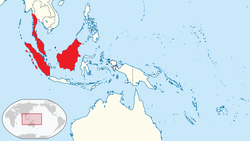Biology:Green broadbill
| Green broadbill | |
|---|---|

| |
| Scientific classification Error creating thumbnail: Unable to save thumbnail to destination
| |
| Domain: | Eukaryota |
| Kingdom: | Animalia |
| Phylum: | Chordata |
| Class: | Aves |
| Order: | Passeriformes |
| Family: | Calyptomenidae |
| Genus: | Calyptomena |
| Species: | C. viridis
|
| Binomial name | |
| Calyptomena viridis Raffles, 1822
| |

| |
The green broadbill (Calyptomena viridis) also known as the lesser green broadbill is a small bird in the family Calyptomenidae. It was formerly classified in the family Eurylaimidae, a group of closely related birds that share the name "broadbill".
Taxonomy
There are three subspecies recognized:[2]
- C. v. viridis Raffles, 1822 - the Malay Peninsula, extirpated from Singapore
- C. v. gloriosa Deignan, 1947 - Sumatra, Borneo, Nias, the Lingga Islands, and the Natuna Islands
- C. v. siberu Chasen & Kloss, 1926 - Mentawai Islands
Prior to revisions by the International Ornithological Congress in 2022, the mainland subspecies went by the name caudacuta, while viridis referred to the Greater Sundaic subspecies. Based on several previous studies finding problems with this nomenclature, the International Ornithological Congress replaced caudacuta with viridis, while gloriosa replaced the former viridis.[3]
Distribution and habitat
The green broadbill is distributed in broadleaved evergreen forests of Borneo, Sumatra, and the Malay Peninsula where it frequents lowland and lower montane rainforest.
Description
The bird is about 17 cm long, plumaged in brilliant green with a black ear patch, widely gaped bill, rounded head, short tail and three black bars on each wing. The beak itself is very weak and almost hidden by the crest above it. Both sexes are similar. The female is duller and has no black markings on its ear patch and wing coverts.
Behaviour
It is often overlooked, as it sits motionless inside the canopy or just below, quickly flying to a new location if disturbed. Its foliage-green color provides excellent camouflage.
It feeds largely on soft figs. The broadbill's feeding habits helps to distribute the seeds of the fig around the forest floor. The female usually lays between two and three whitish eggs, and the young fledge after twenty-two to twenty-three days.
Status and conservation
Although this species remains common in many parts of its large range, it is considered Near Threatened as it is sensitive to habitat loss and degradation, which are likely to be causing population declines throughout its range. Due to continuing habitat loss, the green broadbill is evaluated as Near Threatened on the IUCN Red List of Threatened Species.[1]
References
- ↑ 1.0 1.1 BirdLife International (2016). "Calyptomena viridis". IUCN Red List of Threatened Species 2016: e.T22698750A93702062. doi:10.2305/IUCN.UK.2016-3.RLTS.T22698750A93702062.en. https://www.iucnredlist.org/species/22698750/93702062. Retrieved 12 November 2021.
- ↑ "NZ wrens, Sapayoa, asities, broadbills, pittas – IOC World Bird List" (in en-US). https://www.worldbirdnames.org/new/bow/nz_wrens/.
- ↑ "Subspecies Updates – IOC World Bird List" (in en-US). https://www.worldbirdnames.org/new/updates/subspecies-2/.
- strange, Morten (2000). A Photographic Guide to the Birds of Thailand Including Southeast Asia & The Philippines (1st ed.). Eric Oey (Periplus). ISBN 978-962-593-926-1.
- perrins, Christopher M. (2003). Firefly Encyclopedia of Birds (1st ed.). Firefly Books, Ltd.. ISBN 1-55297-777-3. https://archive.org/details/fireflyencyclope0000unse.
External links
Wikidata ☰ Q305351 entry
 |



